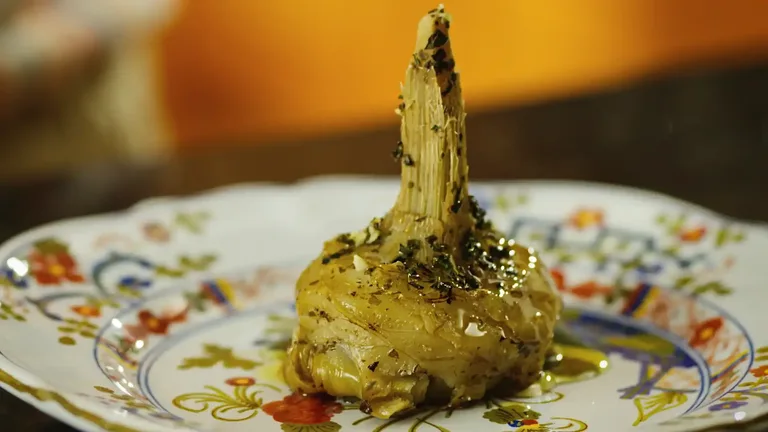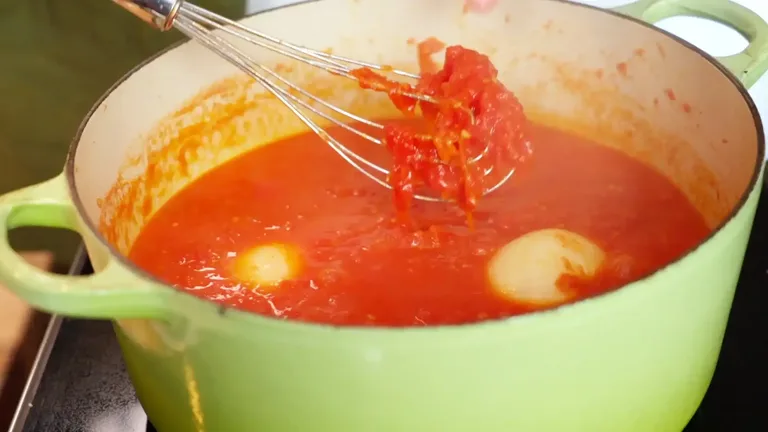
Marcella Hazan’s Roman-style Artichokes
Aug 13, 2025
- Servings
- 4
- Prep time
- 20 minutes
- Total time
- 60 minutes
- Course
- Appetizer
Tags
Ingredients
- 4 large globe artichokes
- ½ lemon
- 3 tablespoons parsley chopped very fine
- 1½ teaspoons garlic chopped very fine
- 6 to 8 fresh mint leaves, chopped fine
- Salt
- Black pepper, ground fresh from the mill
- ½ cup extra virgin olive oil
Instructions
-
In preparing any artichoke it is essential to discard all the tough, inedible leaves and portions of leaves. When doing it for the first time it may seem wasteful to throw so much away, but it is far more wasteful to cook something that can’t be eaten. Begin by bending back the outer leaves, pulling them down toward the base of the artichoke, and snapping them off just before you reach the base. Do not take the paler bottom end of the leaf off because at that point it is tender and quite edible. As you take more leaves off and get deeper into the artichoke, the tender part at which the leaves will snap will be farther and farther from the base. Keep pulling off single leaves until you expose a central cone of leaves that are green only at the tip, and whose paler, whitish base is at least 1½ inches high. Slice at least an inch off the top of that central cone to eliminate all of the tough green part. Take the half lemon and rub the cut portions of the artichoke, squeezing juice over them to keep them from discoloring. Look into the exposed center of the artichoke, where you will see at the bottom very small leaves with prickly tips curving inward. Cut off all those little leaves and scrape away the fuzzy “choke” beneath them, being careful not to cut away any of the tender bottom. If you have a small knife with a rounded point, it will be easier for you to do this part of the trimming. Return to the outside of the artichoke and, where you have snapped off the outer leaves, pare away any of the tough green part that remains. Be careful not to cut off the stem, which, for this dish, must remain attached. Turn the artichoke upside down and you will notice, inspecting the bottom of the stem, that the stem consists of a whitish core surrounded by a layer of green. The green part is tough, the white, when cooked, soft and delicious, so you must pare away the green, leaving the white intact. Pare the stem thus all the way to the base of the artichoke, being careful not to detach it. Rub all the exposed cut surfaces with lemon juice.
-
In a bowl mix the chopped parsley, garlic, and mint leaves, and add salt and a few grindings of pepper. Set aside one-third of the mixture. Press the rest into the cavity of each artichoke, rubbing it well into the inner sides.
-
Choose a heavy-bottomed pot with a tight-fitting lid, such as enameled cast iron, tall enough to accommodate the artichokes, which are to go in standing. Put in the artichokes, tops facing down, stems pointing up. Rub the remaining herb and garlic mixture over the outside of the artichokes. Add all the olive oil, plus enough water to come up and cover one-third of the leaves, but not the stems.
-
Take a sufficient length of paper towels that, when doubled up, will completely cover the top of the pot. Or a muslin cloth will do as well. Soak the towels or cloth in water, and place over the top of the pot, covering it completely. Put the lid over the towels or cloth, then pull back over the lid any portion of them hanging down the sides of the pot.
-
Turn on the heat to medium and cook for 35 to 40 minutes. The artichokes are done when a fork easily pierces the thick part between the stem and the heart. Cooking times may vary depending on the freshness of the artichokes. If they are tough and take long to cook, you may have to add 2 or 3 tablespoons of water from time to time. If, on the other hand, they are very fresh and are cooked before all the water has simmered away, uncover the pot, remove the towels or muslin, and turn up the heat, quickly boiling away the water. The edges of the leaves resting on the bottom of the pot may turn brown, but do not worry, it improves their flavor.
-
When done, transfer the artichokes to a serving platter, setting them down with their stems pointing up. Reserve the olive oil and other juices from the pot: They are to be poured over the artichokes only just before serving. If you were to pour the oil and juices over the artichoke when it is still hot, it would soak them up, making the artichoke greasy and sodden, and depriving it of the sauce with which later you want to accompany it. The ideal serving temperature is when the artichokes are no longer hot, but have not yet cooled completely, when they are still faintly touched by the waning warmth of cooking. But they are excellent even later, at room temperature, as they are usually served in Rome. Plan to use them the same day, however; like all cooked greens, their flavor deteriorates in the refrigerator.




